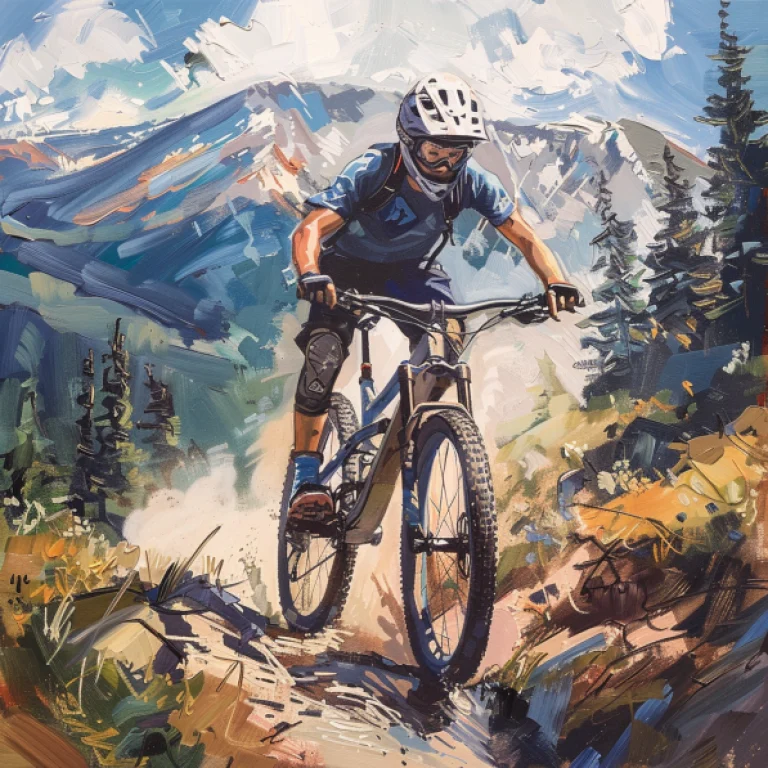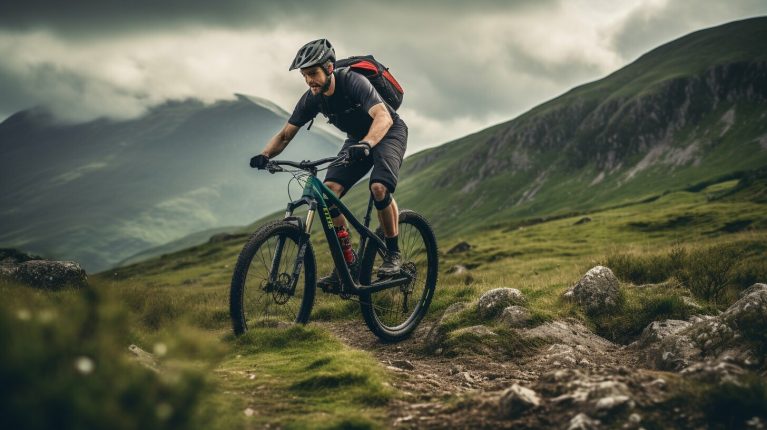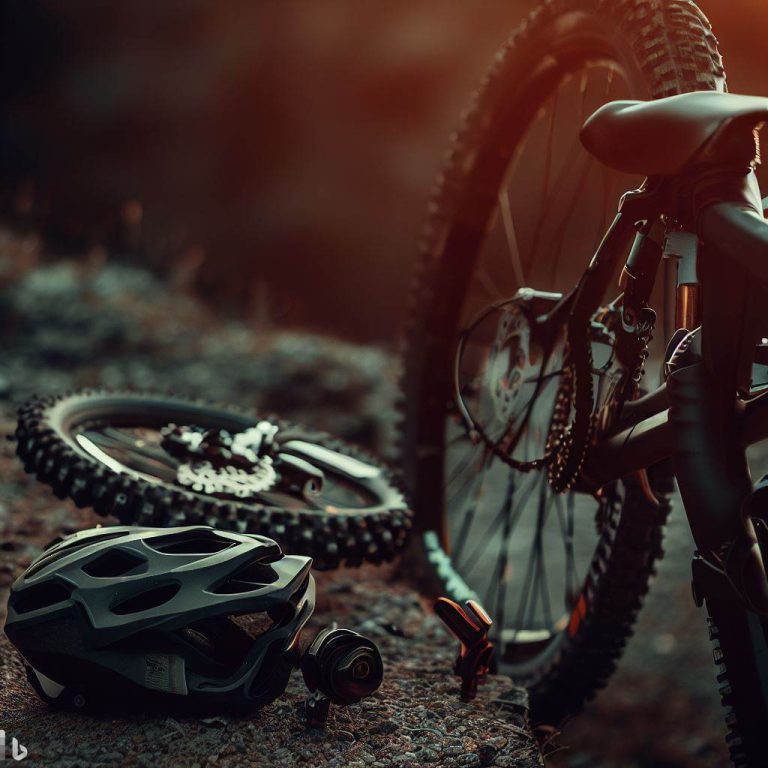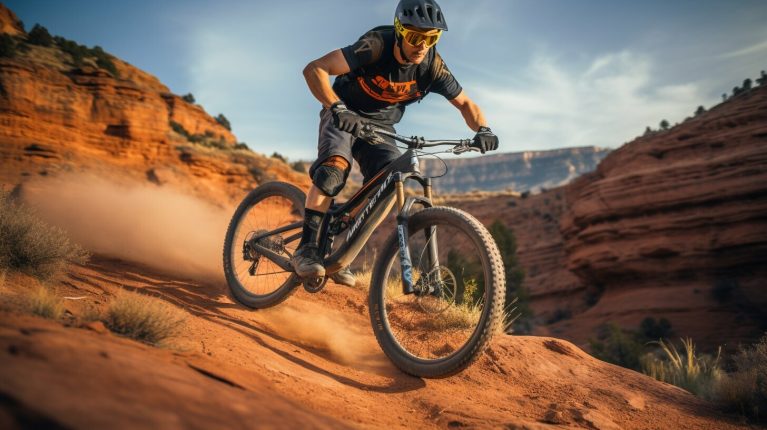If you’re an avid mountain biker, you know that the right equipment can make all the difference in your cycling experience. One crucial component that can greatly affect your enjoyment and performance is your handlebars. Choosing the right mountain bike handlebars can provide you with improved control, comfort, and confidence while riding.
With so many handlebar options available, selecting the perfect one for your needs may seem overwhelming. However, by understanding the various types, materials, and shapes of handlebars, you can make an informed decision that will enhance your riding experience.
Key Takeaways
- Choosing the right handlebars can improve your cycling experience.
- Understanding the types of handlebars available is crucial in determining the perfect one for your needs.
- The material, width, and shape of the handlebar all play a significant role in your control, comfort, and confidence while riding.
Exploring Handlebar Types for Mountain Bikes
Choosing the right handlebars for your mountain bike is crucial for a comfortable and safe riding experience. There are several handlebar types available for mountain bikes, each with its own unique features and benefits.
Flat Bars
Flat bars are the most common type of handlebar found on mountain bikes. They have a simple design and are best suited for cross-country riding. Flat bars provide a low riding position, which improves aerodynamics and provides more control on technical terrain. However, they can cause discomfort to riders with back problems or those seeking a more upright riding position.
Riser Bars
Riser bars are similar to flat bars but have a slight upward curve towards the rider. This design provides a more upright riding position, increasing comfort and reducing strain on the back and shoulders. Riser bars are ideal for trail riding and are popular among beginners and leisure riders.
Drop Bars
Drop bars are commonly found on road bikes but are also used on some mountain bikes. They have a unique design that provides multiple hand positions, allowing riders to adjust their posture during long rides. Drop bars provide excellent aerodynamics, making them ideal for downhill riding, but are not well-suited for technical off-road terrain.
Ultimately, the type of handlebar you choose will depend on your individual riding style and preferences. Consider the terrain you’ll be riding on, your posture, and the level of control you need before selecting the type of handlebar that’s right for you.
Finding the Best Mountain Bike Handlebars
Choosing the right mountain bike handlebars is crucial to enhancing your riding experience. When selecting handlebars, you need to consider factors such as material, shape, and width. The perfect handlebar should suit your riding style, physique, and preferences.
| Material | Description |
|---|---|
| Aluminum | Durable and affordable, but slightly heavier than carbon fiber. |
| Carbon Fiber | Expensive but ultra-lightweight and ideal for high-performance riding. |
| Steel | Strong and affordable but heavier than aluminum and carbon fiber. |
If you are a novice rider or you are on a budget, aluminum handlebars are a solid choice. If you are looking to increase your performance, carbon fiber handlebars are the best option, but they come at a higher price tag. Steel handlebars are affordable and durable, making them perfect for beginners or casual riders.
The shape of your handlebars can affect your riding posture, comfort, and control. Below are the most common handlebar shapes:
- Flat Bars – Straight handlebars that offer a relaxed riding position and more control.
- Riser Bars – Curved handlebars that allow for a more upright riding position and better visibility.
- Swept-Back Bars – Handlebars that curve back towards the rider, providing a more comfortable grip, but less control.
The width of your handlebars also plays a crucial role in your ride quality. Wider handlebars offer better stability and control on rough terrain, while narrower handlebars provide better maneuverability in tight spaces. To determine the ideal handlebar width, measure your shoulder width and choose a handlebar that is slightly wider than your shoulders.
Ultimately, the best mountain bike handlebars are those that provide the right balance of control, comfort, and performance for you. Take your time to research, try different types, and choose the ones that suit your needs and preferences.
Choosing the Right Mountain Bike Handlebar Width
Handlebar width plays a significant role in determining the rider’s control and comfort on the bike. Too narrow and you may feel cramped and lose control, while too wide may cause discomfort and affect your handling ability. The ideal handlebar width is influenced by various factors such as your shoulder width, arm length, and riding discipline.
If you plan to ride on technical trails and need precise control, consider a narrower handlebar between 680mm and 720mm. Wider handlebars from 740mm to 810mm are suitable for downhill riding, providing greater stability and control at high speeds. Cross-country riders may opt for a medium width between 720mm and 740mm, striking a balance between control and comfort.
Measuring your shoulder width is an excellent way to determine the ideal handlebar width. Generally, add 20mm to your shoulder-to-shoulder measurement to get an approximate handlebar width. Additionally, riders with longer arms may prefer wider handlebars to achieve a proper riding position.
It is essential to experiment with different handlebar widths to find the right fit for your individual riding style and preferences. Make sure to take test rides before making a purchase to ensure optimal comfort and control.
Exploring Mountain Bike Handlebar Materials
Mountain bike handlebars are made from a variety of materials, each with its own unique properties. The most common materials used for mountain bike handlebars are aluminum, carbon fiber, and steel.
| Material | Pros | Cons |
|---|---|---|
| Aluminum | Lightweight, affordable, and durable | Can be harsh on rough terrain and less comfortable to ride |
| Carbon Fiber | Extremely lightweight and comfortable to ride | Expensive and less durable than aluminum and steel |
| Steel | Durable and provides a responsive ride | Heavier than aluminum and carbon fiber |
When choosing a material for your mountain bike handlebars, consider your riding style and budget. If you’re a beginner or on a tight budget, aluminum handlebars are a good choice. If you’re an experienced rider looking for more comfort and performance, consider carbon fiber handlebars. Steel handlebars are a great option if you want a durable and responsive ride.
It’s worth noting that many handlebars use a combination of materials to achieve the desired balance of strength, weight, and comfort.
Remember, choosing the right handlebar material is important for both performance and comfort. Consider your riding style and budget when making your choice.
Understanding Mountain Bike Handlebar Shapes
When it comes to mountain bike handlebars, the shape of the bars can make a big difference in how comfortable and in control you feel while riding. While there are numerous handlebar shapes to choose from, the three most common are flat, riser, and swept-back designs. Each shape has its own unique characteristics, making it important to understand the differences to choose the right one for your needs.
Flat Handlebars
As the name suggests, flat handlebars have no rise and are typically straight across. They are popular for cross-country riding because they offer a low and aggressive riding position that allows for efficient power transfer. Flat bars are also a good choice for riders who prefer a more upright riding position, as they can be flipped upside down to create a slight rise.
Riser Handlebars
Riser handlebars have an upward sweep towards the rider. They are a popular choice for trail and downhill riding because they offer a more upright position that provides greater control on technical descents. Riser bars also put less strain on the rider’s back and neck, making them a more comfortable option for long rides. The height of the rise varies between models, so it’s important to consider the amount of rise when selecting riser handlebars.
Swept-Back Handlebars
Swept-back handlebars, also known as cruiser bars, have a backward sweep towards the rider. They are a popular choice for leisurely rides and commuting, as they offer a more upright riding position that places less strain on the back and neck. Swept-back bars are also a good choice for riders who want to maintain an easy grip on the handlebars, as they allow for a wider grip that doesn’t require the rider to reach as far forward.
Enhancing Performance with Mountain Bike Handlebar Risers
Are you looking for ways to boost your performance on your mountain bike? Handlebar risers can have a significant impact on your riding experience. These simple additions to your handlebars can adjust the height and angle of your grips, allowing you to find the perfect position for optimal control and comfort.
Handlebar risers are especially useful for riders who tackle challenging terrain, such as rocky or steep trails. By adjusting the height of your handlebars, you can distribute your weight more evenly and maintain better balance on the bike. This can help you ride more confidently and reduce the risk of falls and accidents.
When choosing handlebar risers, consider factors such as the amount of rise you need, the style of riser, and the material. Some riders prefer a minimal rise of just a few centimetres, while others may benefit from a more dramatic increase in height. You can choose from various styles, such as one-piece or two-piece risers, depending on your preferences and needs.
It’s also essential to choose handlebar risers that are made from high-quality materials, such as aluminum or carbon fiber. These materials are lightweight, durable, and can withstand the wear and tear of intense mountain biking. Investing in quality handlebar risers can make a noticeable difference in your performance and help you ride with greater confidence and control.
Adjusting Mountain Bike Handlebar Height for Optimal Comfort
Handlebar height is a critical factor that affects your comfort and performance while riding your mountain bike. It’s important to adjust the handlebar height to achieve an optimal position that allows you to ride comfortably and with maximum control. Here are some tips to help you adjust your mountain bike handlebar height.
- Consider your body proportions: Every biker is unique, and so are their body proportions. The handlebar height should be adjusted to suit your body and riding style. If you’re tall, you might need to raise your handlebars to avoid feeling cramped; if you’re more petite, you might need to lower them to find a comfortable position.
- Experiment with different heights: Adjust your handlebars in small increments and test ride to see how they feel. Don’t make too many changes at once; it’s best to make slight adjustments and ride for a while to see how they feel before making further adjustments.
- Consider your riding style: The kind of terrain you’re riding on also affects the optimal handlebar height. If you’re riding on steep and technical terrain, you might need to raise the handlebars to increase control. If you’re riding on smoother, flatter terrain, lowering the handlebars might help you achieve more speed.
- Take into account your bike’s geometry: The design of your mountain bike’s frame also affects the ideal handlebar height. Some frames have a more upright position, while others provide a more aggressive, forward-leaning posture. Adjust your handlebars accordingly to find the best position for your bike’s geometry.
Adjusting your mountain bike handlebar height might take some time and experimentation to get it just right. But once you find the sweet spot, you’ll be able to ride for hours without experiencing discomfort and fatigue, enabling you to tackle even the most challenging trails with confidence and ease.
Ensuring a Secure Grip with Mountain Bike Handlebar Grips
While handlebars provide control, comfort and steering, they are not the only important component of your mountain bike’s cockpit. Handlebar grips play an essential role in ensuring a secure grip while riding, which is crucial for both control and safety. The right handlebar grips can provide comfort and reduce hand fatigue, especially during longer rides and rough terrains. Here are some tips for finding and choosing the best handlebar grips for your mountain bike:
Consider the Material
Handlebar grips can be made of various materials, including rubber, foam, silicone and leather. Rubber grips are popular due to their affordability and durability, while foam grips can provide extra cushioning. Silicone grips offer a tackier feel and are also more durable, while leather grips can provide a classic aesthetic and improved grip as they age. Depending on your preferences and riding conditions, you can choose the material that suits you best.
Choose the Right Size
The size of your grips should match the diameter of your handlebars for a secure fit. Most handlebars have a standard diameter of 22.2mm, but some have different sizes that require matching grips. Additionally, grip thickness can vary, and you can choose the size that feels most comfortable in your hand.
Consider the Grip Design
The grip design refers to the texture and contour of the grip surface. Some grips have a smooth surface, while others have patterns or textures to provide better grip. Contoured grips can also provide a more ergonomic shape and reduce hand fatigue. Consider the type of riding you will be doing and whether you need more grip for technical terrains or prefer a smoother surface for casual rides.
Explore Lock-On Grips
Lock-on grips attach to the handlebars using a clamp mechanism, which ensures that they stay in place even during the most demanding rides. These grips are easy to install and remove, and you can adjust their position to suit your preferences. However, lock-on grips can be bulkier than slide-on grips and may add some weight to your bike.
Consider Slide-On Grips
Slide-on grips require no clamps and slide onto the handlebars, providing a seamless fit. They are usually lighter and slimmer than lock-on grips, making them a popular choice among riders who value minimalistic designs. However, slide-on grips may slip during rides and require regular maintenance to keep them in place.
Remember that finding the right handlebar grips is a personal preference and largely depends on your riding style, preferences and terrain. Use these tips to choose the best handlebar grips for your mountain bike and ensure a secure, comfortable and enjoyable riding experience.
FAQ
Q: What are the different types of handlebars available for mountain bikes?
A: The different types of handlebars available for mountain bikes include flat bars, riser bars, and drop bars. Each type has its own characteristics and benefits, catering to different riding styles and preferences.
Q: How do I find the best mountain bike handlebars?
A: Finding the best mountain bike handlebars involves considering factors such as material, width, and shape. It’s important to choose handlebars that suit your individual preferences and riding style, ensuring a comfortable and controlled riding experience.
Q: What is the importance of handlebar width for mountain bikes?
A: Handlebar width plays a crucial role in a rider’s control and comfort. It is influenced by factors like shoulder width and riding discipline. Determining the ideal width for your mountain bike handlebars can enhance your riding experience.
Q: What are the different materials used for mountain bike handlebars?
A: Mountain bike handlebars are commonly made from materials such as aluminum, carbon fiber, and steel. Each material has its own advantages and disadvantages, which should be considered when selecting the handlebars that best suit your needs.
Q: What are the different shapes of mountain bike handlebars?
A: Mountain bike handlebars come in various shapes, including flat, riser, and swept-back designs. The shape of the handlebars can impact your posture, comfort, and control while riding, so it’s important to choose a shape that suits your preferences and riding style.
Q: How can handlebar risers enhance performance?
A: Handlebar risers can enhance performance by adjusting the height and angle of the handlebars. This allows riders to achieve a more comfortable and controlled riding position, especially on challenging terrains. Consider using handlebar risers to improve your performance on the trails.
Q: How do I adjust the mountain bike handlebar height for optimal comfort?
A: Adjusting the handlebar height is crucial for optimal comfort and performance. Factors such as body proportions and riding style should be considered when adjusting the handlebar height to ensure a comfortable and efficient riding position.
Q: What are the different types of mountain bike handlebar grips?
A: There are various types of mountain bike handlebar grips available, including lock-on and slide-on grips. These grips play a significant role in providing comfort and control while riding, so it’s important to choose the right type based on your personal preferences and riding conditions.





